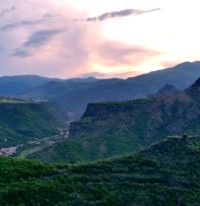Yerevan Cascade
The Yerevan Cascade is another Soviet-era project that was only partially completed in 1991 when the Soviet Union collapsed.
It was conceived as a giant stairway linking the relatively flat area around the Opera House up a steep hill to a series of monuments on the heights above the city, offering unobstructed views of central Yerevan and Mount Ararat.
Yerevan Cascade - conceived as a giant stairway linking the city to a series of monuments on the heights
There are more images in the Armenia Album See more...
The lower, completed part, is quite stunningly clad in white limestone.
Inside the Cascade there are seven pairs of escalators that rise to landings within the complex, some of which connect to exhibit halls that are now elements in the Cafesjian Museum of Art.
The Cascade looks daunting from outside but seven pairs of escalators inside save a lot of climbing
Gerard Cafesjian was a, Brooklyn born, American-Armenian philanthropist and collector (1925-2013), who was gifted the unfinished complex as an art gallery, conditional upon its renovation. His Cafesjian Museum Foundation then invested over 35 million US dollars in stage one of the project that opened again to the public in 2009. He died before a planned top gallery was built.
Outside the flow of the Cascade is interrupted at intervals by fountain courts featuring modernist sculptures from the Cafesjian collection.
Fountain courts interrupt the flow of steps - Ararat in the distance
Wikipedia tells us:
'The majority of the museum's collection are derived from the private collection of the founder Gerard L. Cafesjian. With more than 5,000 works, the centre exhibits one of the most comprehensive glass collections in the world, particularly the works of the Czech couple Stanislav Libenský and Jaroslava Brychtová, whose collaborative work revolutionized the use of glass as an artistic medium. Other important glass artists in the collection include Dale Chihuly, Bohumil Elias, Pavel Hlava, Jaromír Rybák, Ivana Šrámková, Bertil Vallien, Lino Tagliapietra, Mark Peiser, and Hiroshi Yamano. The collection also has substantial holdings in drawing, painting and sculpture by many influential artists including Fernando Botero, Arshile Gorky, Jennifer Bartlett, Lynn Chadwick, Barry Flanagan, Jaume Plensa, and François-Xavier Lalanne'.
Part of the glass collection - reminds me of a Limerick: There was a young man from Madras...
At the base of the Cascade is a garden sculpture court with works by contemporary sculptors including several by Botero.
Works by Botero and several other contemporary sculptors
The top, unfinished, part remains a dilapidated building site. Much of the exposed 1970's concrete is crumbling, exposing the steel reinforcing, and it looks anything but safe. We made our way up some very dodgy stairs and paths to admire the view. It was quite a steep climb.
At the top - the concrete is crumbling - and this is an earthquake area
After our exertions we had earned a coffee at one of the up-market restaurants that line the street adjacent to the lower sculpture gardens.

